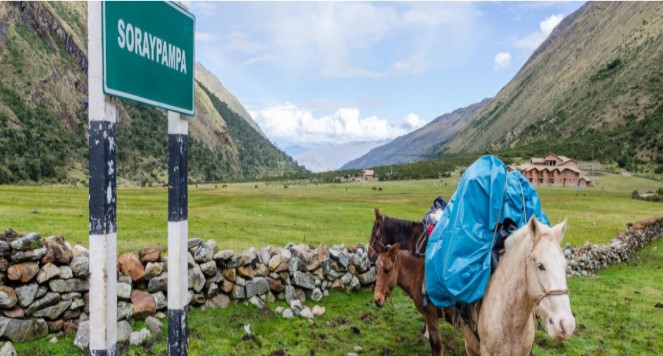Peru’s Andes are home to some of the world’s most dramatic landscapes, and among these the Salkantay Trek 5 Days stands out as a prime route to Machu Picchu. Over five days and four nights, trekkers traverse high mountain passes, snow‑capped peaks, lush cloud forests, and Inca ruins. The Salkantay Trek offers an alternative to the classic Inca Trail—one that is less crowded, more varied in terrain, yet deeply rewarding. This article gives you a full view of the 5‑day Salkantay Trek: itinerary, what to expect, how to prepare, and how to make your journey successful.
What Is the Salkantay Trek?
The Salkantay Trek is a well‑known long‑distance trek in southern Peru, culminating in Machu Picchu. It is often chosen by those who want an alternative to the traditional Inca Trail—one that offers more wilderness, fewer crowds, and a greater variety of scenery: alpine passes, glacial lakes, verdant valleys, and subtropical jungle. One version of the trek is 5 days long (4 nights).
Key features:
- Highest point: the Salkantay Pass (≈ 4,600‑4,650 meters) at day 2.
- Multiple ecosystems: high altitude, cold and often dry at pass, then transitioning down into cloud forests.
- Mixed accommodation: camps, ecological lodges, and sometimes hotel in Aguas Calientes (town below Machu Picchu) on the final night.
Sample 5‑Day Itinerary
Here is a commonly used version of the 5‑day trek. Operators may vary slightly depending on starting point, accommodations, and pace.
What to Expect: Highlights & Challenges
Highlights
- Spectacular mountain vistas: The Salkantay peak itself (often snow‑topped), glaciers, wide Andean panoramas especially around the pass.
- Humantay Lake: Many itineraries include a detour or optional hike to Humantay Lake with its turquoise glacial waters.
- Dramatic ecosystems transitions: From sparse alpine terrain, to cloud forest, to lush jungle, culminating in the Machu Picchu area. This variety is one of the trek’s biggest rewards.
- Ruins & cultural interest: Llactapata ruins are often included; local Andean rural life; possible rituals or cultural exchanges with local communities.
- Sense of achievement: The crossing of the Salkantay Pass and finishing at Machu Picchu make for emotional payoff. Sunrise at Machu Picchu is the crowning moment.
Challenges
- High altitude & thin air: Crossing ~4,600‑4,650 m will affect many—headaches, shortness of breath, fatigue. Proper acclimatization is essential.
- Long hiking days: Day 2 is especially demanding; many days involve 6‑9 hours of walking over uneven terrain.
- Weather variability: Conditions can go from freezing cold at high points to hot and humid in the jungle. Rain during the wet season can make trails muddy, slippery, and more dangerous. Clouds can obscure views.
- Physical demands: Requires good fitness, strong legs, stable hiking boots, and endurance—not just for the pass but for multiple days of walking and descent.
- Logistics & cost: Although no permit is required for the Salkantay trail itself (unlike Inca Trail), you still must have a Machu Picchu entrance ticket; you’ll need good gear; transport; guide or group; often costlier than simpler day hikes.
Preparation: Planning for Success
To get the most out of the trek while staying safe and healthy, proper preparation is non‑negotiable.
Training & Fitness
- Begin fitness training at least two to three months before departure, especially cardio (running, hiking, stair climbing) and leg strength.
- Do practice hikes with a loaded daypack; simulate terrain and distance you might cover in some days.
- Keep up flexibility and rest; include hiking boots used before the trek to avoid blisters.
Acclimatization
- Spend 2‑3 nights in Cusco (≈3,400 m) before the trek to let your body adjust.
- On arrival, take an easy day(s), avoid overexertion. Hydrate well. Consider coca tea (traditional) and light meals. Avoid alcohol.
Gear and Packing
- Layers: base layers, fleece, down or insulated jacket, waterproof shell. Temperatures vary widely.
- Footwear: well‑broken‑in hiking boots; moisture wicking socks.
- Daypack (~25‑35 L) for essentials; the rest (camping gear, duffels) is handled by support staff or mules in many tours.
- Essentials: water purification tablets, headlamp, sun protection (hat, sunscreen), warm gloves, beanie, rain cover.
Timing & Weather
- Best trekking window: dry season — roughly May through September. Shoulder months (April, October) are possible, but rain risk is higher. Wet season (November‑March) brings trail problems.
- Check weather forecasts; be ready for cold nights, possible snow at high zones.
Logistics & Booking
- Arrange transportation from Cusco to the trailhead, and return from Aguas Calientes after Machu Picchu. Many operators bundle train, lodging, and meals.
- Secure your Machu Picchu entrance ticket in advance. If you plan to hike Huayna Picchu or Machu Picchu Mountain, those tickets are very limited.
- Choose a reputable tour operator with safety measures, good reviews, and environmental responsibility.
Health & Safety
- Be aware of altitude sickness symptoms: headache, nausea, dizziness, shortness of breath. If severe, descending is safer.
- First‑aid kit, medications, insect repellent.
- Respect local communities, environment: leave no trace; avoid litter; respect cultural customs.
Tips for a Better Experience
- Start each day early when possible: less heat, better light, more quiet.
- Pace yourself: especially on steeper ascents. Better to go slow and steady.
- Eat well: carbohydrate‑rich meals for energy; snacks like nuts, energy bars.
- Stay hydrated: consume 3‑4 liters of water per day.
- Capture moments but also rest and absorb the surroundings. At high altitude, mental fatigue shows; rest mind and body.
- Pack light: heavier packs increase fatigue. Use porter services where available.
- Consider an extra day of rest in Cusco or Sacred Valley before or after trek, to recover and avoid burnout.
Conclusion & Key Takeaways
The 5‑Day Salkantay Trek is an outstanding adventure, blending rugged scenery, cultural immersion, physical challenge, and the ultimate destination of Machu Picchu. For many, it delivers the thrills and solemn beauty of walking ancient paths less traveled, yet finishes with the magic of one of the New Seven Wonders.
Key Takeaways
- Varied terrain & vistas – Expect dramatic shifts: high mountain passes, glacier‑views, cloud forests, and lush valleys before arriving at Machu Picchu.
- Physical & altitude demands – This is not an easy walk; Day 2’s ascent to ~4,650 m is the most intense. Good fitness, acclimatization, and proper training matter greatly.
- Best time matters – Trek in dry season (May‑Sept) if possible; weather is more predictable, trails safer.
- Gear & logistics are crucial – Layered clothing, broken boots, hydration, plus reliable trek operator and solid planning make the difference between suffering and enjoying.
- Mental rhythm & pacing – Walk your own pace, rest well, savor moments; this makes the journey rewarding, not just reaching the destination.
- Respect & environmental awareness – Leave no trace; act responsibly; learn from locals; hiking is as much about the path as the views.


